Unit 2 Numbers Reading (1)
- 格式:docx
- 大小:15.22 KB
- 文档页数:6
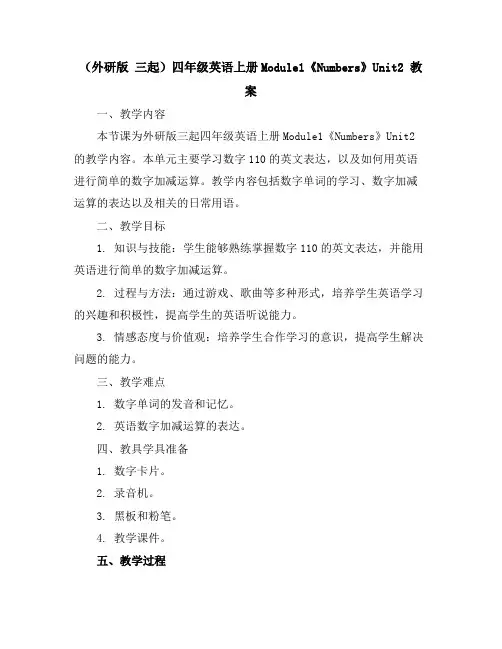
(外研版三起)四年级英语上册Module1《Numbers》Unit2 教案一、教学内容本节课为外研版三起四年级英语上册Module1《Numbers》Unit2的教学内容。
本单元主要学习数字110的英文表达,以及如何用英语进行简单的数字加减运算。
教学内容包括数字单词的学习、数字加减运算的表达以及相关的日常用语。
二、教学目标1. 知识与技能:学生能够熟练掌握数字110的英文表达,并能用英语进行简单的数字加减运算。
2. 过程与方法:通过游戏、歌曲等多种形式,培养学生英语学习的兴趣和积极性,提高学生的英语听说能力。
3. 情感态度与价值观:培养学生合作学习的意识,提高学生解决问题的能力。
三、教学难点1. 数字单词的发音和记忆。
2. 英语数字加减运算的表达。
四、教具学具准备1. 数字卡片。
2. 录音机。
3. 黑板和粉笔。
4. 教学课件。
五、教学过程1. 导入:通过播放数字歌曲,引导学生复习数字110的英文表达。
2. 新课呈现:教师展示数字卡片,教授新单词和句型,并进行示范。
3. 操练:学生分组进行角色扮演,练习用英语进行数字加减运算。
4. 巩固:通过游戏,巩固所学知识。
六、板书设计1. 数字110的英文表达。
2. 数字加减运算的表达。
3. 课堂活动安排。
七、作业设计1.抄写数字110的英文单词,每个单词写5遍。
2.完成练习册P18页的练习。
3.用英语和家人交流数字110。
八、课后反思本节课通过多种形式的教学活动,激发了学生的学习兴趣,提高了学生的英语听说能力。
在教学过程中,教师应关注学生的学习情况,及时进行指导和反馈,确保教学目标的达成。
同时,教师还需关注学生的情感态度与价值观的培养,提高学生的合作意识和解决问题的能力。
在今后的教学中,教师还需不断探索和尝试新的教学方法,以提高教学效果。
一、导入环节导入环节是激发学生学习兴趣的关键。
在本节课的导入环节,可以通过播放一首与数字相关的英文歌曲,如“Ten Little Indians”,来吸引学生的注意力,同时复习和巩固学生对数字110的英文表达。
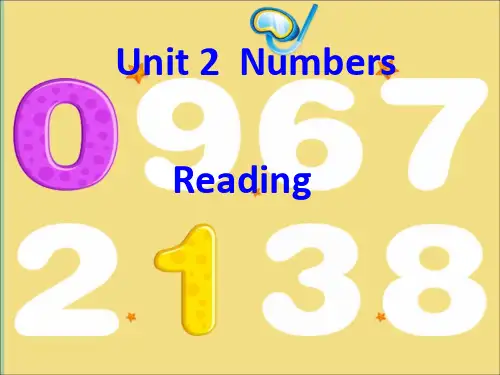
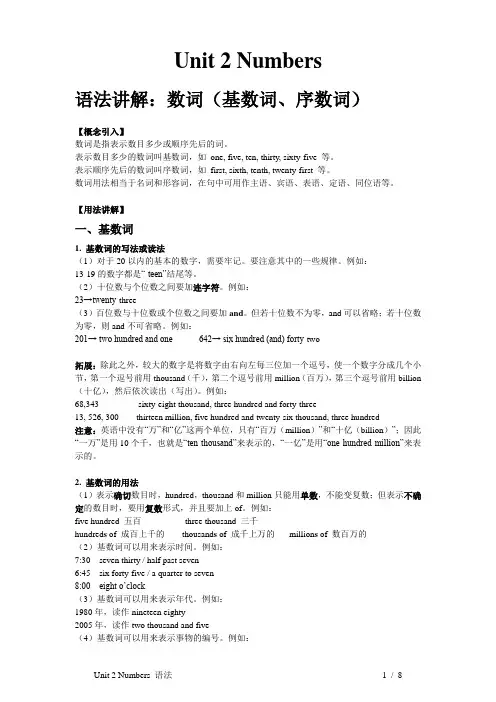
Unit 2 Numbers语法讲解:数词(基数词、序数词)【概念引入】数词是指表示数目多少或顺序先后的词。
表示数目多少的数词叫基数词,如one, five, ten, thirty, sixty-five 等。
表示顺序先后的数词叫序数词,如first, sixth, tenth, twenty-first 等。
数词用法相当于名词和形容词,在句中可用作主语、宾语、表语、定语、同位语等。
【用法讲解】一、基数词1. 基数词的写法或读法(1)对于20以内的基本的数字,需要牢记。
要注意其中的一些规律。
例如:13-19的数字都是“-teen”结尾等。
(2)十位数与个位数之间要加连字符。
例如:23→twenty-three(3)百位数与十位数或个位数之间要加and。
但若十位数不为零,and可以省略;若十位数为零,则and不可省略。
例如:201→ two hundred and one 642→ six hundred (and) forty-two拓展:除此之外,较大的数字是将数字由右向左每三位加一个逗号,使一个数字分成几个小节,第一个逗号前用thousand(千),第二个逗号前用million(百万),第三个逗号前用billion (十亿),然后依次读出(写出)。
例如:68,343 sixty-eight thousand, three hundred and forty-three13, 526, 300 thirteen million, five hundred and twenty-six thousand, three hundred注意:英语中没有“万”和“亿”这两个单位,只有“百万(million)”和“十亿(billion)”;因此“一万”是用10个千,也就是“ten thousand”来表示的,“一亿”是用“one hundred million”来表示的。
2. 基数词的用法(1)表示确切数目时,hundred,thousand和million只能用单数,不能变复数;但表示不确定的数目时,要用复数形式,并且要加上of。
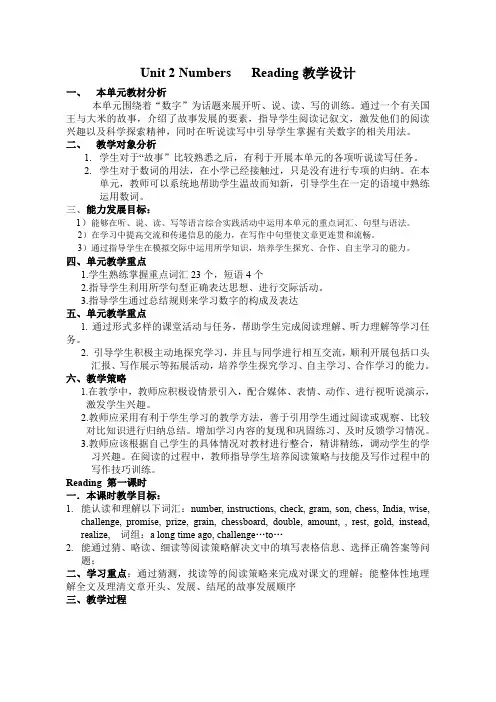
Unit 2 Numbers Reading教学设计一、本单元教材分析本单元围绕着“数字”为话题来展开听、说、读、写的训练。
通过一个有关国王与大米的故事,介绍了故事发展的要素,指导学生阅读记叙文,激发他们的阅读兴趣以及科学探索精神,同时在听说读写中引导学生掌握有关数字的相关用法。
二、教学对象分析1.学生对于“故事”比较熟悉之后,有利于开展本单元的各项听说读写任务。
2.学生对于数词的用法,在小学已经接触过,只是没有进行专项的归纳。
在本单元,教师可以系统地帮助学生温故而知新,引导学生在一定的语境中熟练运用数词。
三、能力发展目标:1)能够在听、说、读、写等语言综合实践活动中运用本单元的重点词汇、句型与语法。
2)在学习中提高交流和传递信息的能力,在写作中句型使文章更连贯和流畅。
3)通过指导学生在模拟交际中运用所学知识,培养学生探究、合作、自主学习的能力。
四、单元教学重点1.学生熟练掌握重点词汇23个,短语4个2.指导学生利用所学句型正确表达思想、进行交际活动。
3.指导学生通过总结规则来学习数字的构成及表达五、单元教学重点1. 通过形式多样的课堂活动与任务,帮助学生完成阅读理解、听力理解等学习任务。
2. 引导学生积极主动地探究学习,并且与同学进行相互交流,顺利开展包括口头汇报、写作展示等拓展活动,培养学生探究学习、自主学习、合作学习的能力。
六、教学策略1.在教学中,教师应积极设情景引入,配合媒体、表情、动作、进行视听说演示,激发学生兴趣。
2.教师应采用有利于学生学习的教学方法,善于引用学生通过阅读或观察、比较对比知识进行归纳总结。
增加学习内容的复现和巩固练习、及时反馈学习情况。
3.教师应该根据自己学生的具体情况对教材进行整合,精讲精练,调动学生的学习兴趣。
在阅读的过程中,教师指导学生培养阅读策略与技能及写作过程中的写作技巧训练。
Reading 第一课时一.本课时教学目标:1.能认读和理解以下词汇:number, instructions, check, gram, son, chess, India, wise,challenge, promise, prize, grain, chessboard, double, amount, , rest, gold, instead, realize, 词组:a long time ago, challenge…to…2.能通过猜、略读、细读等阅读策略解决文中的填写表格信息、选择正确答案等问题;二、学习重点:通过猜测,找读等的阅读策略来完成对课文的理解;能整体性地理解全文及理清文章开头、发展、结尾的故事发展顺序三、教学过程。
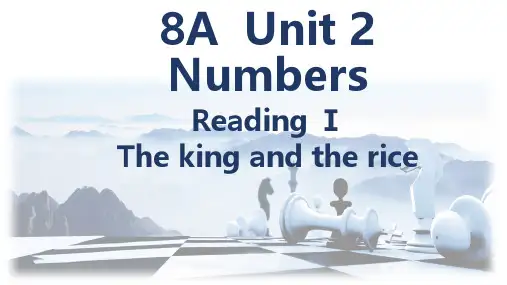
8A Unit 2 NumbersReading ⅠThe king and the riceWhat do you do in your free time?My daughter Kitty is 8 years old. She likes playing Chinese chess.She thinks she is good at playing chess and she is confident, so she always challenge s me to this game.I promise her she can have some prize s if she wins. She is wise and careful, so ˈtʃælɪndʒ]向(某人)挑战ˈprɒmɪs]许诺;承诺ɪz]充满智慧的ɪz]奖赏;奖品chessboard [ˈtʃesˌbɔːd] n. 棋盘square [skwe ə]n. 棋格The amount of the squares on the chessboard is 64.How many square s are there on the chessboard?chess [t ʃes]n. 国际象棋 If we double 64, we will get .128The king and the rice1. Where did the story probablyhappen?A. In China.B. In India. ['indiə]C. In Japan.2. What are they doing?A. Playing chess.B. Drinking tea.The king and the rice Who Where When The king and a wise old man In the king’s palace / In IndiaOne day The beginni ng The ending fable time The middl e Let’s read!They played the game for a long time.challeng ed the old man to a chess game.The king lost the game.01L orem ipsum L orem ipsum L orem ipsum 0305020406A long time ago, there was a king in China. The king’s favourite game was football. One day, the king challenged a stupid old man. He promised he would give the old man any prize if the old man won the game. The old man asked for money only.Finally, the old man lost the game.F FF T F Fconflict (冲Why does the writer choose thistitle?makecontrastconflictWe can feel the story by watchingreadingstressintonationThe king quickly realized the problem — even with all the rice in the country, he would still not have enough rice to put on all the squares!Which word did the reader stress?Why did the reader stress these words?To give us a strong feeling about how surprised the king felt.A long time ago, there was a king in India. Theking’s favourite game was chess.One day, a wise old man came to the palace and the king challenged him to a game. The king promised the old man, “You can have any prize if you win the game.”The old man said, “If I win the game, I’d like one grain of rice for the first square of the chessboard, two for the second, four for the third, and then double the amount for each of the rest of the squares.”“Is that all?” asked the king. “Wouldn’t you like gold or silver instead?”“No, just rice,” replied the old man.The king and the old man played the game for a long time. Finally, the old man won. So the king ordered his men to collect a bag of rice. He put one grain on the first square, two on the second, and so on. The king quickly realized the problem — even To make the story sound real and interesting . We can know more about the characteristics of the two characters.Why did the writer use the dialogues?123456Find out who said these words and try to read it out.I am good at chess. I want to play chesswith you.I think I can make your dream come true.Are you sure you have enough rice for me?Of course. I’m the king.That’s impossible. How could that happen?That’s the secret of Maths.A long time ago, there was a king in India. The king’s favourite game was chess.One day, a wise old man came to the palace and the king challenged him to a game. The king promisedthe old man, “You can have any prize if you win the game.”The old man said, “If I win the game, I’d like one grain of rice for the first square of the chessboard, two for the second, four for the third, and then double the amount for each of the rest of the squares.”“Is that all?” asked the king. “Wouldn’t you like gold or silver instead?”“No, just rice,” replied the old man.The king and the old man played the game for a long time. Finally, the old man won. So the king ordered his men to collect a bag of rice. He put one grain on the first square, two on the second, and so on. The king quickly realized the problem — evenWe can feel the story bywatchingreadingstressintonation.actingintonationgesturesfacialexpressionsA long time ago, there was a king in India. Theking’s favourite game was chess.One day, a wise old man came to the palace and theking challenged him to a game. The king promisedthe old man, “You can have any prize if you winthe game.”The old man said, “If I win the game, I’d like onegrain of rice for the first square of the chessboard,two for the second, four for the third, and thendouble the amount for each of the rest of thesquares.”“Is that all?” asked the king. “Wouldn’t you likegold or silver instead?”“No, just rice,” replied the old man.The king and the old man played the game for along time. Finally, the old man won. So the kingordered his men to collect a bag of rice. He put onegrain on the first square, two on the second, and soon. The king quickly realized the problem — even I am good at chess. I want toplay chess with you.I think I can make your dreamcome true.Of course. I’m the king.That’s impossible. How couldthat happen?Are you sure you have enoughrice for me?That’s the secret of Maths.What will happennext?What will the king say or do ?What will the wise old man say or do?What should I do?What can we learn from the story?Try our best to learn Maths well because numbers and Maths are amazing!Don’t be too proud and be modest though you are really good at something!123Think twice before making a promise because to make a promise is easier than to keep one!The king and the rice Who Where When The king and a wise old man In the king’s palace / In IndiaOne day The beginni ng The ending fable time The middl e They played the game for a long time.challeng ed the old man to a chess game.The king lost the game.Let’s summarize!B Find out more interesting stories about numbers or wise men online and share them with your classmates.CThink about what will happen next and try towrite it down.ARetell the story.Homewo rk。
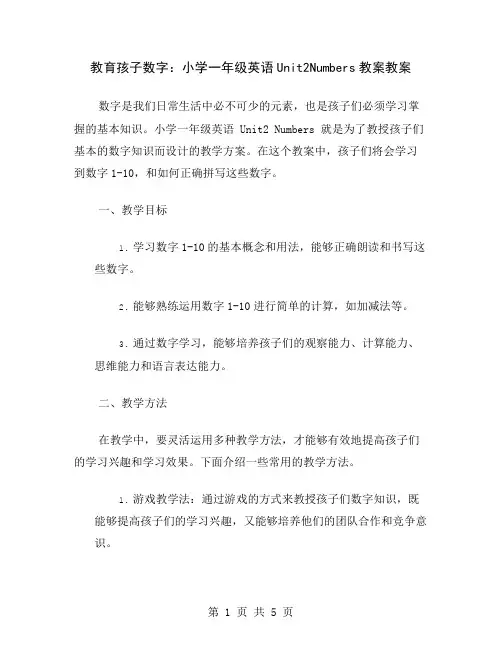
教育孩子数字:小学一年级英语Unit2Numbers教案教案数字是我们日常生活中必不可少的元素,也是孩子们必须学习掌握的基本知识。
小学一年级英语 Unit2 Numbers 就是为了教授孩子们基本的数字知识而设计的教学方案。
在这个教案中,孩子们将会学习到数字1-10,和如何正确拼写这些数字。
一、教学目标1.学习数字1-10的基本概念和用法,能够正确朗读和书写这些数字。
2.能够熟练运用数字1-10进行简单的计算,如加减法等。
3.通过数字学习,能够培养孩子们的观察能力、计算能力、思维能力和语言表达能力。
二、教学方法在教学中,要灵活运用多种教学方法,才能够有效地提高孩子们的学习兴趣和学习效果。
下面介绍一些常用的教学方法。
1.游戏教学法:通过游戏的方式来教授孩子们数字知识,既能够提高孩子们的学习兴趣,又能够培养他们的团队合作和竞争意识。
2.观察教学法:通过观察各种数字和图形,来帮助孩子们认知和理解数字,同时也能够培养他们的观察能力和思维能力。
3.模拟教学法:通过模拟实际生活中的场景和情境,来锻炼孩子们的数字应用能力,同时也能够培养他们的创新思维和语言表达能力。
三、教学内容1.数字1-10的基本概念和用法数字1-10是数字学习中最基础的内容,在教学中要让孩子们正确理解和掌握这些数字的用法和含义。
可以通过观察数字卡片或制作数字图案等方式来帮助孩子们记忆和理解数字1-10。
2.数字1-10的正确读法和书写方法正确朗读数字和书写数字是学习数字的重要部分,孩子们应该在教学中加强练习,熟练掌握数字1-10的读写技巧。
可以通过听、说、读、写等方式来进行数字练习,提高孩子们的语音和语言表达能力。
3.数字1-10的简单计算数字1-10的计算是学习数字的重要环节,孩子们应该在教学中加强运算练习,熟练掌握数字计算的技巧。
可以通过加减法游戏等方式来进行数字运算,促进孩子们数学思维的发展。
四、教学步骤1.学习数字1-5通过展示数字卡片或图案,让孩子们学习数字1-5的基本概念和用法,同时指导他们正确朗读和书写这些数字。
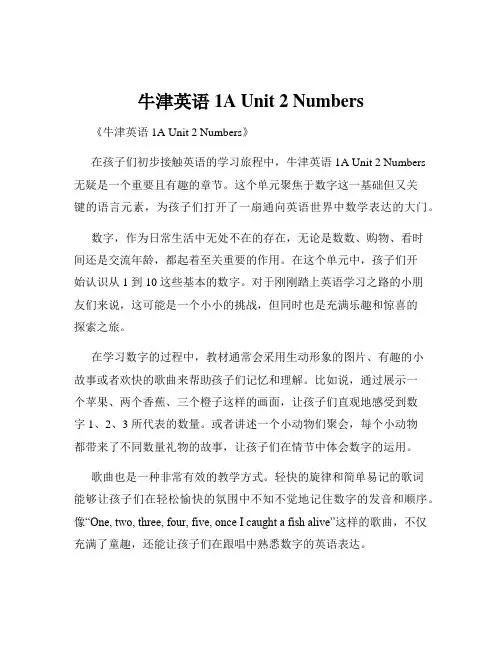
牛津英语1A Unit 2 Numbers《牛津英语 1A Unit 2 Numbers》在孩子们初步接触英语的学习旅程中,牛津英语 1A Unit 2 Numbers 无疑是一个重要且有趣的章节。
这个单元聚焦于数字这一基础但又关键的语言元素,为孩子们打开了一扇通向英语世界中数学表达的大门。
数字,作为日常生活中无处不在的存在,无论是数数、购物、看时间还是交流年龄,都起着至关重要的作用。
在这个单元中,孩子们开始认识从 1 到 10 这些基本的数字。
对于刚刚踏上英语学习之路的小朋友们来说,这可能是一个小小的挑战,但同时也是充满乐趣和惊喜的探索之旅。
在学习数字的过程中,教材通常会采用生动形象的图片、有趣的小故事或者欢快的歌曲来帮助孩子们记忆和理解。
比如说,通过展示一个苹果、两个香蕉、三个橙子这样的画面,让孩子们直观地感受到数字 1、2、3 所代表的数量。
或者讲述一个小动物们聚会,每个小动物都带来了不同数量礼物的故事,让孩子们在情节中体会数字的运用。
歌曲也是一种非常有效的教学方式。
轻快的旋律和简单易记的歌词能够让孩子们在轻松愉快的氛围中不知不觉地记住数字的发音和顺序。
像“One, two, three, four, five, once I caught a fish alive”这样的歌曲,不仅充满了童趣,还能让孩子们在跟唱中熟悉数字的英语表达。
除了图片、故事和歌曲,课堂上的互动游戏也是必不可少的。
老师可以组织孩子们进行数字接龙的游戏,一个孩子说出“One”,下一个孩子接着说“Two”,以此类推。
或者进行猜数字的游戏,老师在心里想一个数字,让孩子们通过提问来猜出这个数字。
这些游戏不仅增加了学习的趣味性,还能让孩子们在实际运用中巩固所学的知识。
在学习数字的同时,孩子们还会接触到与数字相关的一些简单的数学概念,比如数量的比较。
他们会学习到“more”(更多)和“less”(更少)这两个词,并且能够通过观察图片或者实物来判断哪个数量更多,哪个数量更少。
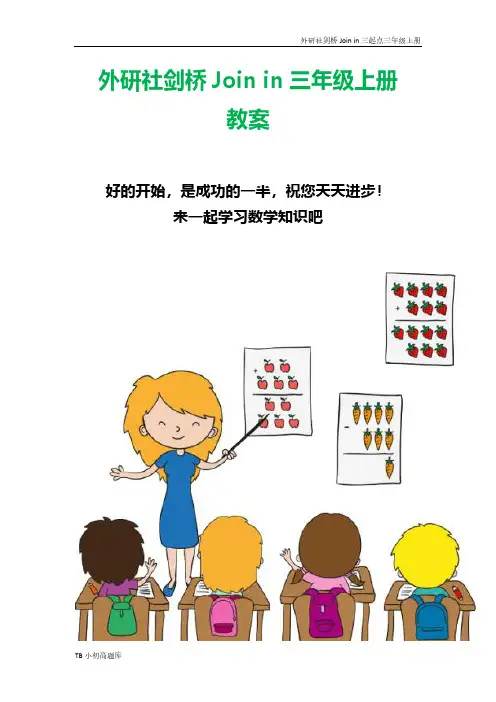
外研社剑桥Join in三年级上册教案好的开始,是成功的一半,祝您天天进步!来一起学习数学知识吧Unit2 Numbers 第1课时教学设计【内容来源】Join In三起点(2012年版)三上Unit2 Numbers【主题】Part 1a,1b【课时】第1课时一、教学目标(Teaching aims)能在图片和动作的提示下听懂、学说歌谣The tiger jump.并正确指认图片和做出相应的动作。
二、教学重难点(Teaching points and difficulties)学生模仿并快速融入课堂,为后面的学习做好铺垫。
三、教学准备(Teaching preparation)课件、音频(教师可以在优教平台直接调用或下载)四、教学过程Step 1: Warm-up教师与学生打招呼,播放第1单元8b数字歌,并做动作。
带领学生说one, two, three, four, five, six。
Step 2: Presentation教师带上头饰,自我介绍:I’m tiger. Look at me. I’ll show you the tiger jump.教师播放歌曲,并伴以体态语,帮助学生初步感知和理解歌曲内容。
请学生打开课本到第12页。
仔细观察图片,了解动作。
再次播放歌曲,让学生模仿动作。
可以进行2-3遍。
第三次播放歌曲,并让学生看着课本图片,进行跟唱。
Step 3: Practice1. 老师说数字,学生做动作,老师做动作,学生说数字。
Step 4: Consolidation老师说数字,学生指课本上对应的图片。
按顺序-打乱顺序进行练习。
Step 5: Summary老师与一起说数字,引导学生说出本单元的话题单词numbers。
Step6: Homework登陆优教同步学习网,听课本第12页Part1录音并跟唱3遍。
【板书设计】Unit2 NumbersThe tiger jumpThe tiger jump, the tiger jump.Come on, let’s do the tiger jump.Ten, nine, eight, seven, six, five, four, three, two, one, zero.Yippee!相信自己,就能走向成功的第一步教师不光要传授知识,还要告诉学生学会生活。
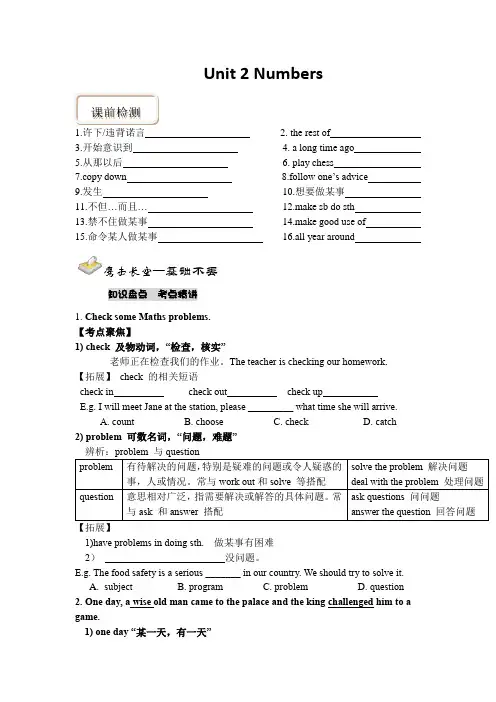
Unit 2 Numbers1.许下/违背诺言2. the rest of3.开始意识到4. a long time ago5.从那以后6. play chess7.copy down 8.follow one’s advice9.发生10.想要做某事11.不但…而且…12.make sb do sth13.禁不住做某事14.make good use of15.命令某人做某事16.all year around1. Check some Maths problems.【考点聚焦】1) check 及物动词,“检查,核实”老师正在检查我们的作业。
The teacher is checking our homework.【拓展】check 的相关短语check in check out check upE.g. I will meet Jane at the station, please _________ what time she will arrive.A. countB. chooseC. checkD. catch2) problem 可数名词,“问题,难题”辨析:problem 与questionproblem有待解决的问题,特别是疑难的问题或令人疑惑的事,人或情况。
常与work out和solve 等搭配solve the problem 解决问题deal with the problem 处理问题question意思相对广泛,指需要解决或解答的具体问题。
常与ask 和answer 搭配ask questions 问问题answer the question 回答问题【拓展】1)have problems in doing sth. 做某事有困难2)没问题。
E.g. The food safety is a serious _______ in our country. We should try to solve it.A.subjectB. programC. problemD. question2. One day, a wise old man came to the palace and the king challenged him to agame.1) one day “某一天,有一天”课前检测辨析:one day与some dayI think ,my dream will come true 。
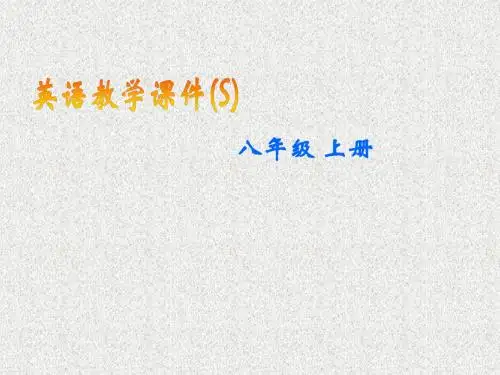
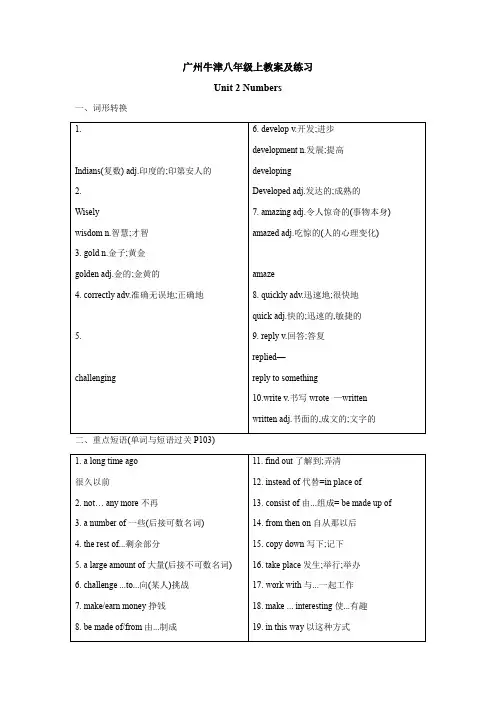
广州牛津八年级上教案及练习Unit 2 Numbers一、词形转换二、重点短语(单词与短语过关P103)三、重点句型(读背记)1. India→n./adj.2. wise→adv.3. gold→adj. 6.challenge→n.(指人)7.challenge→adj.8. develop→n.9. develop→adj.(两个)10. amaze→adj.(两个)11. include →prep.12. quick→adv.4. correct→adv.5. wise→n.13. reply→过去式14. write→adjUnit 2 NumberV ocabulary (1)基础识记一、根据要求写出相应的单词。
1. gram (复数)2. India (形容词)3. wise(副词)4. copy (第三人单数)5. correctly (形容词)6. promise (过去式)7. reply (过去式) 8. final (副词)9. forty (序数词) 10. lazy (比较级)二、根据句意及首字母提示写单词,完成句子。
11. D 18 by 3, and you get 6.12. After finishing your test, you should c it again.13. The c is a board with 64 black and white squares, on which you play chess.14. The rich man paid a large a of money for the diamond.15. There were five bags. I carried two bags and the man carried the r .三、用括号内所给的词的适当形式填空。
16. The group of people are from (Indian).17. The roofs of the temple are made of (golden).18. The teacher ordered the student (challenge) him to a game.19. My father (promise) me a nice present on my birthday and he did it.20. Mike won the game for (copy) the Chinese words well and fast.21. The 21—year—old young man always does things according to his boss's (instruct).22. —How many times should I take the medicine, doctor?— (two) a day.23. Our teachers' office is on the (five) floor.24. 3 (multiply) by 6 equals 18.25. Please teach me how (fly) kites.四、选出符合题意的最佳答案。
小学一年级英语教案:Unit 2 - Numbers教学目标通过本节课的教学,学生将能够: - 认识并正确书写1-10的数字 - 听懂并能准确发音1-10的数字 - 用英语表达1-10的数字 - 进行简单的数字对话教学准备•PPT幻灯片•教学卡片:1-10的数字•教学音频:1-10的数字发音教学步骤引入新知1.导入上节课所学的内容(英语问好语、颜色)–英语问好语:Hello, Good morning, Good afternoon–颜色:红色(red)、绿色(green)、蓝色(blue)2.引入新单词:numbers–出示单词“numbers”并发音–学生独立朗读并模仿发音,感受发音的差异学习数字3.出示教学卡片:数字1–教师引导学生读音,让学生独立朗读并模仿发音–教师书写数字1,并让学生模仿书写4.以同样的方式,逐个出示教学卡片:数字2-10–教师引导学生读音,让学生独立朗读并模仿发音–教师书写数字2-10,并让学生模仿书写5.教师复习所学数字–出示数字1-10的教学卡片,依次叫数字,并让学生朗读–通过反复练习巩固数字的发音和书写数字对话6.学生练习进行数字对话–教师出示数字对话的示例(如:A: What’s your favorite number? B: My favorite number is 3.)–学生分组进行对话练习,互相问候并询问对方的喜欢的数字7.学生表演数字对话–学生两人一组,表演数字对话–学生之间可以使用课上学到的其他英语表达(问好语、颜色等)游戏时间8.进行数字游戏–教师设计一个数字游戏,让学生猜测或拼写数字,通过游戏巩固所学数字知识–学生参与游戏,加深对数字的理解和记忆课堂总结通过本节课的学习,我们学习了数字1-10的发音和书写,还学会了进行数字对话和参与数字游戏。
在以后的学习中要继续巩固所学数字,并通过不断练习提高对数字的运用。
作业布置1.完成课堂练习册Unit 2的相关练习2.复习数字1-10的发音和书写,独立完成练习纸上的数字书写练习(1-10)延伸活动•编写数字歌曲或谜语•观看与数字相关的英语动画片,并进行小组讨论•用数字进行加减法练习,在游戏中培养数字敏感度以上为小学一年级英语教案:Unit 2 - Numbers的教学大纲,通过本节课的学习,学生将能够掌握1-10的数字发音和书写,并能够进行简单的数字对话。
Teaching design—— 8AU2 ReadingTeaching contentsThis is a reading lesson, which presents a story about numbers.Teaching objectives(1) Knowledge objectivesStudents can learn some key words and useful expressions;Students can get the basic elements of the story.(2) Ability objectivesAfter the lesson, students are able to describe the story and express their opinions;Students can speak out their thoughts about the topic in a logical way and develop their critical thinking ability;Students can master correct ways to use numbers in their daily conversation.(3) Emotional objectivesStudents’ interest of learning English can be improved;Students can get to know the importance of keeping a promise.Teaching key pointsHelp students get the key elements and the process of the story andmaster some new words.Teaching difficult points:Lead student to use personas, and then students would analyze the consequences of different choices if they were the main characters in the story.Teaching procedureStep1: Warm-upUse a mathematical problem to raise students’interest and lead to the topic naturally.Step2: Pre-readingAsk students to predict by observing the pictures, the title of the story and the first sentences of paragraph 1 and 2.Step3: While-reading1. Ask students to read the story and divide it into 3 parts;2. While listening to the tape, students can examine them part by part;3. By asking students to do some exercises, the teacher can instruct students to summarize the main idea of each part in one sentence. Step4: Post-reading1. Ask students to retell the story according to the hints;2. Ask students to think. “If they were the king, what would they do?”;3. Present teacher’s opinion of this topic.Step5: AssignmentAsk students to design an ending to finish the story and act it out with their friends.。
1. Translate Chinese into the English words:number_________ gram ______ son ________ chess _____________ India _________ wise ______ challenge ________ promise _________ prize _________grain _________ chessboard __________ double _____________ amount ____________ rest ________gold____________instead ____________realize _____________a long time ago ______________ challenge ... to...___________2.完成What do you know about部分,即A1部分3. 课文朗读:朗读文章注意语音语调,并了解文章大意。
并完成Before you read部分问题:(预设的问题,旨在指导学生有目的的阅读课文,对课文有初步感知。
)1.Who are the people in the first picture?a. The king and his son.b. The king and his brother.c. The king and an old man.2. What are they doing?a Playing chess.b Growing rice.c Playing cards.3 Where did the story probably happen?a In China.b In India.c In Japan.1.预习反馈:2.出示学习目标:3.探究点一:(完成单元卡通图)Look at the cartoon on page 17 and answer the questions1.What’s in Lo’s right hand?_________________________________________________________________________ 2. What’s in Hi’s hands?_________________________________________________________________________3. What question did Lo ask?____________________________________________________________4. What did Hi say?___________________________________________________________________________ ____探究点二:(词汇处理)一、Listen to the tape二、Read the article by ourselves三、Guess the new words:1.When you ask a wise person for help, a. you tell him/her that you willgive him/her the present for sure2.If you promise somebody a present, b. you know something is wrong.3.If you get a prize in a game, c. you get the number4.4.When you double the number 2, d. you want him/her to give yougood advice.5.When you realize the problem, e. you win something for doingwell.探究点三:(对文章大意的理解)Read the article and answer the questions:1When and where did this story happen?_______________________________________________________2What was the K ing’s favourite game?_______________________________________________________3Who/Whom did the King challenge to a game one day?_______________________________________________________4What did the King promise the old man?________________________________________________________5What did the old man want to have if he won the game?________________________________________________________6Who won the game?________________________________________________________7What did the King realize at last?________________________________________________________探究点四:(对文章的整体把握)D1 Read the story on page19 and complete the table below.一、根据括号中的汉语提示填入适当的英语单词1.Not a ________of rice should be wasted.(谷粒)2.They are having a game of ______on the chessboard.(国际象棋)3.His poem won the first______of ten dollars.(奖赏,奖品)4.Every time I _________him to a game,he refuses me.(挑战)5.There is a large_______of work for us to do.(数量,数额)6.Tommy _______that he would go to school earlier the next day.(许诺)7.The little children learned five________last week.(数字)8.Mr.Brown has a daughter and two______.(儿子)9.The number of the students in Park School ______in two years.(加倍)10._________is an Asian country with a long history.(印度)二、用括号中所给单词的适当形式填空。
Unit 2 NumbersThe king and the riceA long time ago, there was a king in India. The king’s favourite game was chess.One day, an old wise man came to the palace and the king challenged him to a game. The king promised the old man, “ You can have any prize, if you win the game.”The old man said “If I win the game, I’d like one grain of rice for the first square of the chessboard, two for the second, four for the third and then double the amount for each of the rest of the squares.“Is that all?” asked the king. “ Wouldn’t you like gold or silver instead?”“ No, just rice,” replied the old man.The king and the old man played the game for a long time. Finally, the old man won. So the king ordered his men to collect a bag of rice. He put one grain on the first square, two on the second , and so on. The king quickly realized the problem-------even with all the rice in the country, he would still not have enough rice to put on all the squares!1.check in 登记check up 检验check out 办清手续后离开2.基数词+单位名称(metre, feet, kilometer等)+adj(long, wide, high等)3.play chess 下象棋play with 玩耍4.favourite adj. 最喜欢的,(无比较级和最高级)5.one day (过去,将来)的某一天some day (将来)的某一天6.the rest of 剩余的……have a rest 休息下7.promise sb sth 答应给某人某物promise sb to do sth 答应某人做某事make a promise 许诺8.would like sth 想要某物would like to do sth 想要做某事would like sb to do sth 想要某人做某事9.instead (句首,句末)代替,而不是instead of 代替,而不是10.特殊疑问词+to do11.realize sth 意思到……realize that 意思到……12.enough +n. 或n.+ enough足够多的……Adj+enough 足够……13.talk to sb 和某人谈话(暗含上级对下级的意思)talk with sb 和某人谈话talk about sth 谈论某事14.advice n.(不可数)some advice 一些建议a piece of advice 一条建议give sb advice 给某人建议15.follow/take one’s advice 听从某人的建议16. a bag of ...一包……17.and so on 等等Counting before numbersBefore the invention of written numbers, people used many different ways to count things.At first, people use their fingers, and even their toes. However, they could only count small numbers in this way.After that, they began to make small marks on sticks and bones. This helped them count bigger numbers. They used them to count the days of the month, the amount of food and the number of animals they have.Then people began to use tokens made from clay or small stones. This helped them count even bigger numbers. They often put the tokens on pieces of string so that they could carry them around easily. This developed into tools like the abacus.Finally, people began to develop systems of written marks to show different numbers, and this led to the Hindu---Arabic system(0-9). We are still using this system today.1.at first 起初,开始2. a piece of string 一根绳子3.develop into 发展成……4.lead sb to ...带某人去……lead sb to do sth 带领某人做某事5.agree with sb 同意某人agree to do sth 同意做某事6.not ...any more =no more = not....any longer= no longer不再7.take place 发生happen 发生8.at once 立刻9.as usual 和往常一样10.keep your dream 坚持你的梦想11.not.....at all 一点也不12.besides 除了……还有except for 除了……(不同类)except 除了……(同类)but 除了13.be late for 迟到14.all year round 全年,整年15.order sb to do sth 命令某人做某事。
Unit 2 Numbers第2课时 Reading (2)课内基础练一、根据句意及首字母提示完成句子1. My grandparent’s s________ is my father.2. He is a very ________ man. He knows a lot.3. He c________ John to as soon as he saw him.4. My mother p________ to buy me an encyclopaedia for my birthday last Sunday.5. How can I d________ my money within two years?6. He has a large a________ of money, so he can afford the house.7. We’ll eat some of the bread and keep the r________ for breakfast.8. The expensi i8’’=ve bracelet(手链) is made of g________.9. Does he r________ his mistake?10. To keep fit, we should have more vegetables and fruit i________ of too much meat.二、用适当的介词或副词填空1. He comes from China, but he lives ________ Indian.2. Our team will challenged theirs ________ a football game.3. I have finished part of the work. Can you finish the rest ________ it?4. He is writing a letter to his pen friend ________ a pencil.5. From then ________ he refused to talk about it.三、单项选择。
1. --- I will buy you a new bike if you learn how to swim this summer.--- Is that a ________? I am sure I’ll get the bike.A. chanceB. promiseC. trickD. treat2. Dad will give ________ to me ________ my fourteenth birthday.A different something; on B. something different; onC something different; in D. different something; in3. --- Can you speak Chinese, Steve?--- Ye, only ________. I have been in China for only one month.A. fewB. a fewC. littleD. a little4. --- ________ good advice! It's so helpful to us.--- Thank you.A. HowB. WhatC. What aD. How a5. Our teachers usually give us some ________ on how to face the difficulties and challenges________.A advice; brave B. advices; braveC. advices; bravelyD. advice; bravely6. Nowadays, each of the students in the countryside ________ a new dictionary.A. hasB. hadC. haveD. having7. Many people are on the playground. Some of them are singing, and the rest ________ dancing.A. beB. isC. amD. are8. The boy was so hungry that he ate ________ this morning.A. three bowls of ricesB. three bowl of riceC. three bowl of riceD. three bowls of rice9. --- Your brother is an excellent basketball player.--- So he is. He ________ to play basketball three years agoA. has startedB. startsC. startedD. star四、根据所给中文意思,完成下列各句。
1.我喜欢和爸爸一起下国际象棋。
I like to ________ _________ with my father.2.很久以前,这里没有人居住。
________ _________ ________ _________, there weren’t people living here.3.咱们去远足而不是待在家里,好吗?Let’s go hiking ________ _________ staying at home, shall we?4. 王先生一年到头努力工作。
Mr Wang works hard ________ _________ ________.5.这个故事发生在一个令人昏昏欲睡的夏日午后。
The story ________ _________ on a drowsy summer afternoon.课外提升练五、语法选择Let me tell you a story. Once upon a time, there was __1__ old farmer. He loved money very much. He kept a lot of gold coins but __2__ used them. He __3__ not give them to others. He put them into an __4__ box and put it in the ground. He came to the __5__ every day to look at it. This made him happy, __6__, when he came to the place, he could not __7__ the box. He became very, very sad. He began to cry. __8__ a man came to him and said, “Don’t cry. Put a stone in the ground instead, and __9__ it is a box of gold coins. A stone will be __10__ the same, because when coins were there, y ou never used them.”1. A. a B. the C. an D. /2. A. often B. never C. nearly D. almost3. A. did B. could C. would D. should4. A. empty B. paper C. blue D. strong5. A. earth B. ground C. place D. there6. A. After day B. Sometimes C. One day D. From them on7. A. find B. finding C. found D. finds8. A. So B. Then C. But D. And9. A. say B. let C. think D. know10. A. just B. still C. already D. ever六、阅读填空As we know, there are differences between Western culture and Chinese culture. __1________ Let's look at some words about animals and plants. Most expression in Chinese about the dog, for example, “a homeless dog”, “a mad dog”, “a running dos” and “a dog catching a mouse”, have bad meanings. __2_________ In English, people use the dog to describe good actions. For example, “you are a lucky dog” means you are a lucky person. And “every dog has its day” means each person has good luck sometimes. To describe a person’s serious illness, they say “sick as a dog”.The word “dog-tired” means “very tired”.__3________ But in Western culture. “cat” is often used to describe a woman who is unkind. There are many other examples of how “cat” is used differently as well.__4__ People think the rose stands for love, peace, courage and friendship. America and many other countries.__5__ We can learn about many differences in cultures by comparing how some words are used.A. However, Chinese love cats very much.B. The words about plants and animals are used in good or bad ways in different cultures.C. We can see differences when pay attention to the way words are used.D. But in Western countries, dogs are considered to be honest and good friends of humans.E. The rose is regarded as a symbol of love in both China and some Western countries.参考答案:一、1. son2. wise3. challenged4. promised5. double6. amount7. rest8. gold9. realize10. instead二、1. in2. to3. of4. with5. on三、1-5 BBDBD 6-9 ADDC 四、1. play chess2. A long time ago3. instead of4. all year round5. took place五、1-5 CBAAC 6-10 CABCB六、1-5 CDAEB。